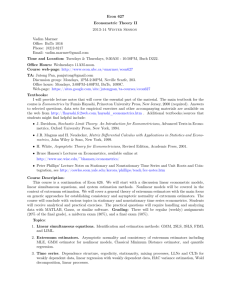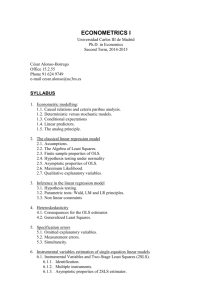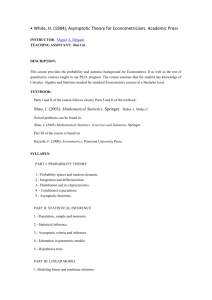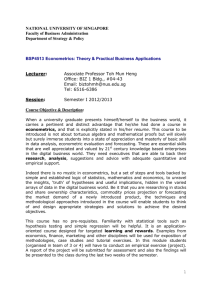Applications of Asymptotic Statistical Decision Theory in Econometrics
advertisement
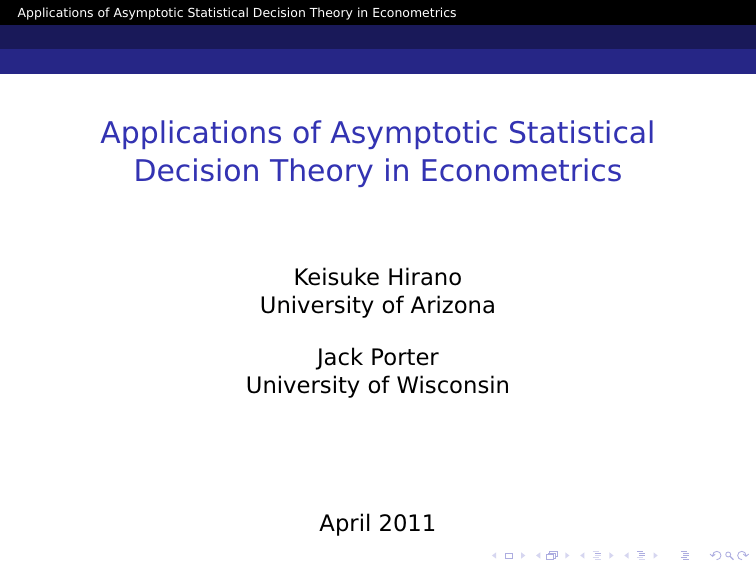
Applications of Asymptotic Statistical Decision Theory in Econometrics
Applications of Asymptotic Statistical
Decision Theory in Econometrics
Keisuke Hirano
University of Arizona
Jack Porter
University of Wisconsin
April 2011
Applications of Asymptotic Statistical Decision Theory in Econometrics
Introduction and Outline
Asymptotic Statistical Decision Theory
A perspective, and also a toolkit.
Perspective:
Specify possible probability distributions, possible
actions, and consequences of actions
Evaluate procedures by their performance under
“all possible” probability distributions.
Toolkit:
Simplification of statistical problems
Use results from classic statistical decision theory
in new contexts.
Applications of Asymptotic Statistical Decision Theory in Econometrics
Introduction and Outline
Outline
Wald Framework
Le Cam’s Approach and the Asymptotic
Representation Theorem
Nondifferentiable Functionals
Treatment Rules
Applications of Asymptotic Statistical Decision Theory in Econometrics
Wald Framework
Wald Framework
Parameter space: Θ
Observe a random variable Z whose distribution is
determined by θ ∈ Θ.
Statistical Experiment: {Pθ : θ ∈ Θ}.
Decision Problem characterized by an action space
A and loss function L(θ, a) : Θ × A → R.
Applications of Asymptotic Statistical Decision Theory in Econometrics
Wald Framework
A decision procedure δ(z) maps realizations of Z
into actions.
Risk of procedure δ:
R(θ, δ) = Eθ [L(θ, δ(Z))] =
Z
L(θ, δ(z))dPθ (z).
We usually extend these definitions to allow for
auxiliary randomization (e.g. δ(z, u) where u is
independent random variable).
Applications of Asymptotic Statistical Decision Theory in Econometrics
Wald Framework
In general, risk functions for different procedures cross.
Can rank rules by:
Bayes risk: let be a prob. measure on θ, and
define
Z
r(, δ) =
R(θ, δ)d(θ).
Minmax risk: evaluate δ by
sup R(θ, δ).
θ∈Θ
Minmax regret, Gamma-minmax, etc.
Applications of Asymptotic Statistical Decision Theory in Econometrics
Wald Framework
Normal Shift
Example: Normal Shift
Let Θ = R, and let Pθ be the N(θ, 1) distribution, i.e. the
model is
Z ∼ N(θ, 1).
Point estimation: A = Θ = R, and we interpret d(z) as a
point estimate of θ.
Squared Error Loss: L(θ, a) = (θ − a)2 .
What is the “best” point estimator of θ?
Applications of Asymptotic Statistical Decision Theory in Econometrics
Wald Framework
Normal Shift
Notice that {Pθ : θ ∈ Θ} has an additive shift
(translation) structure.
Consider equivariant estimators:
δ(z + c) = δ(z) + c.
⇒ δ(z) = δ(0) + z.
Hence every equivariant estimator must have the
form δ(z) = z + b for some constant b.
Applications of Asymptotic Statistical Decision Theory in Econometrics
Wald Framework
Normal Shift
By the Hunt-Stein theorem, we can restrict
attention to equivariant estimators.
Moreover, equivariant estimators have constant
risk over θ.
So it is easy to solve for “best” estimator.
In this example, δ(z) = z is minmax, MLE, and
flat-prior Bayes.
Applications of Asymptotic Statistical Decision Theory in Econometrics
Wald Framework
Normal Shift
Similar arguments can be used for:
Other translation-equivariant models,
e.g. multivariate normal with known variance
matrix, exponential shift.
Other loss functions that have a translation form:
L(θ, a) = f (θ − a).
Randomized estimators.
On the other hand, most econometric models are not
translation-equivariant and are too complex to derive
exact optimality results.
Applications of Asymptotic Statistical Decision Theory in Econometrics
Le Cam Framework
Le Cam Framework
Consider a finite-dimensional parametric model:
iid
Z1 , Z2 , . . . ∼ Pθ ,
where
θ ∈ Θ ⊂ Rk .
For given n ≥ 1, can view data as Z(n) = (Z1 , . . . , Zn ) and
statistical model as
En = {Pnθ : θ ∈ Θ}.
This defines a sequence of statistical experiments.
Applications of Asymptotic Statistical Decision Theory in Econometrics
Le Cam Framework
Suppose {En } satisfies the usual (DQM) smoothness
condition.
As n → ∞, the parameter θ can be “learned” perfectly.
Local reparametrization:
fix θ0 , consider sequences of
p
parameters θ0 + h/ n for h ∈ Rk .
p
The 1/ n rate has the property that the likelihood ratio
dPθ0 +h/ pn
dPθ0
has nondegenerate limit.
(Z(n) )
Applications of Asymptotic Statistical Decision Theory in Econometrics
Le Cam Framework
Let J0 denote Fisher information for the parametric
model at θ0 . (assume nonsingular)
Let δn be a (normalized) sequence of statistics/decision
rules satisfying:
h
δn Lh ,
(1)
p
h
where indicates weak convergence under θ0 + h/ n
to laws Lh .
Example:
δn =
p
n(θ̂ML − θ0 ).
Applications of Asymptotic Statistical Decision Theory in Econometrics
Le Cam Framework
Asymptotic Representation Theorem
Van der Vaart (1991): for any rule δn satisfying (1),
there
exists a randomized rule δ∗ (Z, U), where
Z ∼ N h, J0−1 such that
Lh = Lh [δ∗ (Z, U)] ,
Limit distributions of δn are matched by the exact
distributions of some rule (δ∗ ) in the N(h, J0−1 ) model.
N(h, J0−1 ) is the limit experiment. (Le Cam)
Applications of Asymptotic Statistical Decision Theory in Econometrics
Le Cam Framework
This characterizes limits of every possible decision rule,
and suggests to “solve” the problem in the normal case.
Typically, it is possible to construct matching sequences
of estimators in the original experiment:
MLE in original experiment will be matched by MLE
in limit experiment.
Bayes (with smooth prior) will be matched by
flat-prior Bayes in the limit experiment.
For point estimation, this gives optimality of MLE
and Bayes.
Applications of Asymptotic Statistical Decision Theory in Econometrics
Le Cam Framework
The ART can be extended to semiparametric
problems where Θ is infinite-dimensional, and to
some nonregular models.
There is a different, nonlocal approximation theory
for nonparametric regression and density
estimation (e.g. Nussbaum, Brown and Low).
Applications of Asymptotic Statistical Decision Theory in Econometrics
Application: Nondifferentiable Functionals
Application: Nondifferentiable Functionals
Consider
iid
Yi ∼ G θ ,
θ ∈ Θ ⊂ Rk .
Object of interest:
κ(θ) = min{θ1 , . . . , θk }.
This type of problem arises in bounds/moment
inequality models (quantity of interest is bounded
above by two features of the data).
Applications of Asymptotic Statistical Decision Theory in Econometrics
Application: Nondifferentiable Functionals
For example:
Manski-Pepper (2000): bounds on treatment effects
defined by maxima and minima of conditional
expectations.
Haile-Tamer(2003): Gm (b) is CDF for bids in
auctions with m bidders. If bidders bid no more
than their valuation, valuation CDF satisfies
F(v) ≤ min Gm (v).
m
Andrew-Soares (2007): general inference
procedures for moment inequality models.
Applications of Asymptotic Statistical Decision Theory in Econometrics
Application: Nondifferentiable Functionals
Typically there exist estimators θ̂n satisfying
p
p
h
n(θ̂n − θ0 − h/ n) N(0, J0−1 )
(asymptotically unbiased, local asymptotic minmax).
But
κ̂n := κ(θ̂n )
will be biased (downwards) due to min operator.
Can bias be removed? What is optimal estimator?
Applications of Asymptotic Statistical Decision Theory in Econometrics
Application: Nondifferentiable Functionals
Le Cam framework suggests to consider the limit
experiment:
Z ∼ N(h, J0−1 ),
where J0 is known.
Let δ(Z) be an estimator of κ(h).
Applications of Asymptotic Statistical Decision Theory in Econometrics
Application: Nondifferentiable Functionals
Argument adapted from Blumenthal and Cohen (1968).
Suppose δ(Z) is unbiased:
Eh [δ(Z)] = κ(h)
Write
Eh [δ(Z)] =
Z
∀h ∈ Rk .
δ(z)dN(z|h, J0−1 )dz.
Applications of Asymptotic Statistical Decision Theory in Econometrics
Application: Nondifferentiable Functionals
Unbiasedness condition implies validity of
differentiating under the integral sign, so:
∂
∂h1
Eh [δ(Z)] =
Z
−(z1 − h1 )δ(z)dN(z|h, J0−1 )dz,
and LHS is well defined.
Since Eh [δ(Z)] = κ(h), κ(h) must be differentiable in h1 .
Applications of Asymptotic Statistical Decision Theory in Econometrics
Application: Nondifferentiable Functionals
Unbiasedness condition implies validity of
differentiating under the integral sign, so:
∂
∂h1
Eh [δ(Z)] =
Z
−(z1 − h1 )δ(z)dN(z|h, J0−1 )dz,
and LHS is well defined.
Since Eh [δ(Z)] = κ(h), κ(h) must be differentiable in h1 .
Contradiction: κ(h) is not differentiable at h1 = h2 .
Applications of Asymptotic Statistical Decision Theory in Econometrics
Application: Nondifferentiable Functionals
Hence in the limit experiment there exists no unbiased
estimator for κ(h).
Can also show:
Reducing bias will eventually cause variance to
diverge.
There exists no estimator satisfying the (general)
equivariance condition:
h
δ(z) − κ(h) ∼ F,
where F does not depend on h.
∀h,
Applications of Asymptotic Statistical Decision Theory in Econometrics
Application: Nondifferentiable Functionals
Another classic result (Fraser, 1952): for J0 = Ik , under
mild conditions on δ, the following cannot hold:
Ph [δ(Z) ≥ κ(h)] = β
∀h.
So no median unbiased estimator (β = .5).
Applications of Asymptotic Statistical Decision Theory in Econometrics
Application: Nondifferentiable Functionals
Back to the original problem:
We are doing asymptotics
under local sequences of
p
parameters θ0 + h/ n.
Value of θ0 will matter.
If θ0 = (γ, γ, . . . , γ), then
1
p
κ(θ0 + h/ n) = θ0 + p κ(h1 , . . . , hk ).
n
Applications of Asymptotic Statistical Decision Theory in Econometrics
Application: Nondifferentiable Functionals
Consider estimator κ̂n with
p
p
h
n(κ̂n − κ(θ0 + h/ n)) Lh ,
Locally unbiased estimator: mean of Lh equals 0 for
all h.
Regular estimator: Lh does not depend on h.
(e.g. N (0, )).
Locally median unbiased: Lh has median 0.
Applications of Asymptotic Statistical Decision Theory in Econometrics
Application: Nondifferentiable Functionals
By ART, limit distributions Lh are matched by
distributions of some feasible estimator in the
N(h, J0−1 ) experiment.
But we know there exist no exactly unbiased or
equivariant estimators in the multivariate normal
model, and no median unbiased estimators under
some restrictions.
Hence, no asymptotically unbiased, regular, or
median unbiased estimators.
Applications of Asymptotic Statistical Decision Theory in Econometrics
Application: Nondifferentiable Functionals
On the other hand, can study the limiting version of
the problem, and compare procedures.
Standard optimality results do not hold, but some
minmax results available (Blumenthal and Cohen,
Song).
Can also numerically study the limit experiment:
Applications of Asymptotic Statistical Decision Theory in Econometrics
Application: Nondifferentiable Functionals
-0.6
-0.4
Min
Bayes
BBC
Threshold sqrt(2)
HT w=2
-0.8
Bias
-0.2
0.0
Bias for h1 = 0, h2 ≥ 0
0
2
4
6
h2
8
10
Applications of Asymptotic Statistical Decision Theory in Econometrics
Application: Nondifferentiable Functionals
1.0
0.9
Min
Bayes
BBC
Threshold Shrinkage
Logit Shrinkage
0.8
MSE
1.1
1.2
MSE
0
2
4
6
h2
8
10
Applications of Asymptotic Statistical Decision Theory in Econometrics
Application: Treatment Assignment Rules
Application: Treatment Assignment Rules
Treatment: T = 0, 1 (e.g. job training vs. wage
subsidy).
Potential Outcomes: Y0 , Y1 , with distributions
F0 (·|θ), F1 (·|θ).
Social Planner chooses a treatment rule
δ = Pr(T = 1).
(Could make this conditional on observed
individual’s characteristics X.)
Applications of Asymptotic Statistical Decision Theory in Econometrics
Application: Treatment Assignment Rules
Social welfare under treatments 0,1:
w0 (θ), w1 (θ).
Welfare contrast: g(θ) = w1 (θ) − w0 (θ). Assume
continuously differentiable.
Applications of Asymptotic Statistical Decision Theory in Econometrics
Application: Treatment Assignment Rules
Manski, Dehejia: view this as a statistical problem.
There is data Z(n) that is informative about θ:
Z(n) ∼ Pnθ .
Example: Z(n) obtained from a randomized
evaluation.
Statistical treatment rule:
δn (z(n) ) = Pr(T = 1|Z(n) = z(n) ).
Applications of Asymptotic Statistical Decision Theory in Econometrics
Application: Treatment Assignment Rules
There is some finite-sample theory (Stoye) but
difficult in many settings.
We consider asymptotic approximations.
As before, consider sequences
p
θ0 + h/ n.
Under regularity conditions, will exist consistent,
asymptotically normal estimators for θ.
Applications of Asymptotic Statistical Decision Theory in Econometrics
Application: Treatment Assignment Rules
If, say, g(θ0 ) > 0, then for all h, treatment 1 is
(eventually) better and we can learn this.
But if g(θ0 ) = 0, then
p
p
ng(θ0 + h/ n) → ġ0 h,
and in the limit, we cannot learn perfectly which
treatment is better.
So localizing at θ0 s.t. g(θ0 ) = 0 gives a nontrivial
limiting decision problem.
Applications of Asymptotic Statistical Decision Theory in Econometrics
Application: Treatment Assignment Rules
Consider a sequence of treatment rules {δn }.
Let
βn (h) = Eθ0 +h/ pn δn (Z(n) ) .
If ∃β(·) s.t.
βn (h) → β(h)
∀h,
Then by ART, exists a rule δ∗ in the simple experiment
Z ∼ N(h, J0−1 ) s.t.
β(h) = Eh [δ (Z)] =
∗
Z
δ∗ (z)dN(z|h, J0−1 ).
Applications of Asymptotic Statistical Decision Theory in Econometrics
Application: Treatment Assignment Rules
The limiting version of the problem is one where we
observe
Z ∼ N(h, J0−1 ),
and have a binary choice where payoffs are based on
ġ0 h.
It can be shown that for many loss functions of interest,
can restrict attention to rules of the form
δ(z) = 1(ġ0 Z > c)
Argument works along one-dimensional subspaces for h
and uses Neyman-Pearson Lemma.
Applications of Asymptotic Statistical Decision Theory in Econometrics
Application: Treatment Assignment Rules
Easy to solve for minmax rule: optimization over a
scalar c.
Also easy to solve for flat-prior Bayes.
Hirano and Porter (2009): local asymptotic minmax and
Bayes-optimal rules, also for semiparametric versions
of the problem, generally of the form
1(g(θ̂n ) > cn ),
where θ̂ is an efficient estimator.
Applications of Asymptotic Statistical Decision Theory in Econometrics
Application: Treatment Assignment Rules
Extension: Dynamic Treatment Rules
(incomplete)
Murphy (2003), Robins (2004): how to construct
rules for assigning treatments over time.
Example: modify drug dosages based on
intermediate outcome measures.
Use data (from other subjects) to construct
dynamic rules.
But focus so far is on estimating (infeasible) optimal
rules, not viewing as a statistical decision problem.
Applications of Asymptotic Statistical Decision Theory in Econometrics
Application: Treatment Assignment Rules
A simple two-period version:
T1 → X → T2 → Y.
T1 , T2 : binary treatments.
X: intermediate outcome (assume discrete).
Y: final outcome.
Applications of Asymptotic Statistical Decision Theory in Econometrics
Application: Treatment Assignment Rules
Suppose
X|T1 = t1 ∼ FX (·|θ, t1 ),
Y|T1 = t1 , X = x, T2 = t2 ∼ FY (·|θ, t1 , x, t2 ),
and there is data
Z(n) ∼ Pnθ .
Dynamic statistical treatment rule: a pair δn = (δn1 , δn2 ),
where
δn1 (zn ) = Pr(T1 = 1|Zn = zn );
δn2 (zn , t1 , x) = Pr(T2 = 1|Zn = zn , t1 , x).
Applications of Asymptotic Statistical Decision Theory in Econometrics
Application: Treatment Assignment Rules
Suppose that for every h
βn1 (h) = Eθ0 +h/ pn [δn1 (Zn )] → β1 (h)
βn2 (h; t1 , x) = Eθ0 +h/ pn [δn2 (Zn , t1 , x)] → β2 (h; t1 , x)
By ART, there exists a joint rule
δ∗ (Z) = (δ1∗ (Z), δ2∗ (Z; t1 , x))
such that when Z ∼ N(h, J0−1 ), the distribution of δ∗ (Z) is
the same as the limiting distribution of δn .
Applications of Asymptotic Statistical Decision Theory in Econometrics
Application: Treatment Assignment Rules
In period 2, for a given t1 , x, treatment decision is same
as previous single-period problem.
Can use previous results to get optimal δ2∗ and
associated risk.
It remains to work out δ1∗ .
Applications of Asymptotic Statistical Decision Theory in Econometrics
Application: Treatment Assignment Rules
Conclusion
Asymptotic statistical decision theory: an
approximation technique for models and statistical
decision problems.
Still need to solve decision problem in the limit
experiment; sometimes much easier.
Can also be used for nonregular experiments: limit
experiment not normal.

